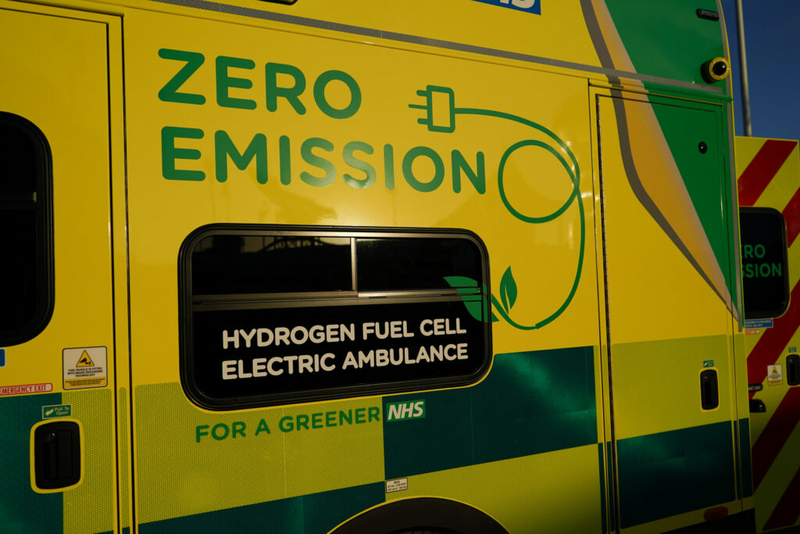It’s not all lithium all the time: DOE commits millions to hydrogen fuel research

Battery-powered electric vehicles have dominated the debate over the future of green technology, but the White House is eyeing another clean fuel alternative based on the most abundant resource in the universe — hydrogen.
The Department of Energy announced plans last week to award up to $47 million in funding to accelerate the research, development, and demonstration of affordable clean hydrogen technologies.
On earth, pure hydrogen is scarce. Instead it mainly exists combined with oxygen in the form of water.
Fuel hydrogen is created by splitting molecules through a process called steam reforming or electrolysis. Once pure hydrogen is formed, it can be burned or mixed with oxygen in a fuel cell to create an electric reaction that can be used as fuel. And the only emissions created by the process is pure water.
However, for clean hydrogen to realize its full potential, costs and other challenges to reach at-scale adoption need to be addressed.
The funding announced by DOE is barely a shadow of the hundreds of millions the administration has committed to spending on conventional vehicle electrification infrastructure. For example, earlier this month the administration announced a $700 million financing package for a single project, the proposed Rhyolite Ridge lithium mine in Esmeralda County.
But the DOE says the hydrogen investment will provide funds for projects that promise to reduce costs, enhance hydrogen infrastructure, and improve the performance of hydrogen fuel cells — advancing the department’s goal of reducing the cost of clean hydrogen from about $5 per kilogram to $1 per kilogram within a decade. The energy in a kilogram of hydrogen is roughly equivalent to that in a gallon of gas, according to the DOE.
Cost reductions will accelerate the use of clean hydrogen across multiple sectors including those hardest-to-decarbonize like heavy industry and long-distance transportation, according to U.S. Secretary of Energy Jennifer Granholm.
“This funding will advance cutting-edge research and drive down technology costs to help unlock the full potential of clean hydrogen energy—providing another valuable resource to combat the climate crisis while creating economic opportunities in communities across the country,” Granholm said.
Fuel cell projects under the funding will focus on applications for heavy-duty trucks, to reduce carbon dioxide emissions and eliminate tailpipe emissions that are harmful to local air quality.
Reducing emissions in industrial sectors through hydrogen fuel would be especially beneficial for disadvantaged communities that have suffered disproportionately from local air pollution in the past, according to the department.
NASA started using hydrogen fuel cells to generate electricity in its space capsules in the 1960’s. Today it’s used in various industries and is being considered as a fuel source for automobiles.
Since 2015, three hydrogen -powered cars have been offered for sale from three different car companies: the Honda Clarity Fuel Cell, the Hyundai Nexo SUV, and the Toyota Mirai. California has also implemented medium- and heavy-duty buses using hydrogen fuel. One significant benefit to hydrogen fuel cell vehicles is that it takes about the same time as filling a tank with gas, say auto developers.
Hydrogen fuel would require costly large-scale infrastructure development, but technological advances are making hydrogen production more efficient and cheaper. Those advances, along with governments’ commitment to decarbonization could help drive a new clean hydrogen economy.
But how clean hydrogen is depends on how it’s produced. Most hydrogen currently produced in the U.S. uses a steam-reforming process via natural gas called “grey” hydrogen. “Green” hydrogen is produced by an electrolysis process with clean energy. “Blue” hydrogen is produced from fossil-fuel coupled with carbon capture, in which CO2 is filtered out of emissions and stored underground, though there are increasingly more efforts to find beneficial uses for that carbon.
The research, development, and demonstration funding announced last week by the department is meant to work in concert with hydrogen-related development funded by last year’s Bipartisan Infrastructure Law.
Under that bill, the U.S. Department of Energy is authorized invest $7 billion to fund up to 10 regional clean hydrogen hubs, defined as “a network of clean hydrogen producers, potential clean hydrogen consumers and connective infrastructure located in close proximity” to be sited across the country.
Funding for those hydrogen hubs come with some restraints, however. For example, at least one hub must produce hydrogen from fossil fuels (with carbon capture), another must be from nuclear and one must be from renewable energy. They will also need to be located in different regions of the U.S. and use energy resources that are abundant in that region, DOE documents state.
The Inflation Reduction Act signed into law last year also created a clean hydrogen production tax credit and enacted big changes in carbon capture tax credits that could also boost hydrogen.
The DOE funding is part of the Biden’s administration’s goal of achieving a 100% clean electric grid by 2035 and a net-zero emissions economy by 2050.
The Hydrogen and Fuel Cell Technologies Office will administer the funding opportunity, with the concept paper phase application due Feb. 24 and the full application due April 28, according to the department.








